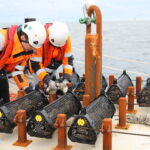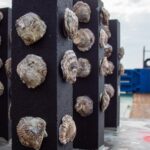Construction of an oyster bank in Gemini offshore wind farm
Objectives
To restore a large-scale European flat oyster reef and enhance biodiversity in the North Sea.
Short description
In 2021, The Rich North Sea programme joined forces with Gemini Windfarm and researchers from Wageningen Marine Research, the Royal Netherlands Institute for Sea Research (NIOZ), and Waterproof and Waardenburg Ecology. The project titled ‘Windfarm Initiated Nature Development with Native Oyster Reefs (WINOR)’, aims to conduct and learn about European flat oyster restoration experiments at the Gemini ZeeEnergie Offshore Wind FarmThe Gemini wind park is located approximately 85 kilometres off the north coast of the Netherlands, it comprises 150 turbines and can provide 785,000 households per year with sustainable electricity. and actively restore one of the largest oyster reefs ever found in the North Sea.
Gemini ZeeEnergie is located near former oyster grounds, where the conditions are suitable for oyster reef formation due to a less dynamic seabed compared to other parts of the North Sea. Given these circumstances, researchers decided to experiment with loose oysters and substrate (shell material and BESE-paste) instead of using broodstock structures for the project. In the first phase, over 1,500 oysters and 18 tons of shells were deployed on the seabed of the wind farm. During the second phase, in summer of 2022, an additional 3,000 oysters and 48 tons of shell material were deployed. The hope is that, over time, the oysters and shell material will settle and form a reef that attracts other marine species.
Cutting-edge ecological monitoring methods were used to understand the patterns of survival, growth, reproduction, and settlement of the oysters. These methods included ROV and dropcam video footage, water sampling for eDNA analyses, and larvae counts. During monitoring, it was found that after the first year (2021), both substrate and oyster density had become too low for accurate measurements. The second deployment (2022) was slightly adjusted to create more compact sites. Subsequent monitoring (2023) showed positive outcomes, with a notable presence of both living and deceased oysters, as well as substrate, within the deployment area. eDNA results of 2021 and 2023 revealed 19 and 21 species respectively, with minor differences in species composition and no significant difference in observed reef species at the different sampling locations. Monitoring efforts will continue in the coming years.
Criteria for selection: 1 + 2 + 3 + 4 (a) + 5
Information updated on: 4 December 2024




